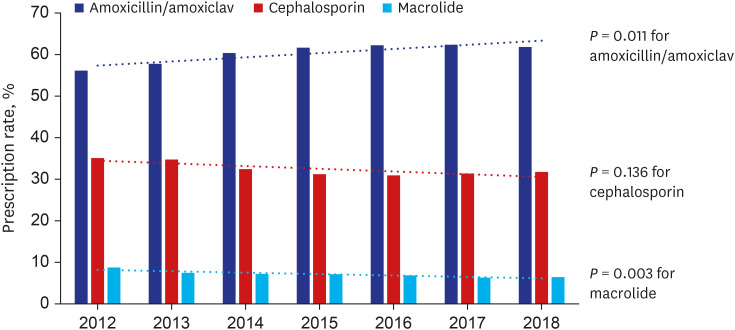J Korean Med Sci.
2021 Nov;36(46):e317. 10.3346/jkms.2021.36.e317.
Trend of Antibiotic Use in Children with Acute Otitis Media in Korea
- Affiliations
-
- 1Department of Pediatrics, Korea University Anam Hospital, Seoul, Korea
- 2Department of Preventive Medicine, Korea University College of Medicine, Seoul, Korea
- 3School of Pharmacy, Sungkyunkwan University, Suwon, Korea
- 4Department of Social and Preventive Medicine, Hallym University College of Medicine, Chuncheon, Korea
- KMID: 2522889
- DOI: http://doi.org/10.3346/jkms.2021.36.e317
Abstract
- Public interventions have shown to optimize the use of antibiotics in children with acute otitis media (AOM). In this study, we describe the AOM-related antibiotic use among children in South Korea using national cohort data. We retrieved the Health Insurance Review & Assessment Service data to construct a national cohort of children aged 0–6 years who had been diagnosed with AOM between 2012 and 2018. Of 25,212,264 children included, the antibiotic prescription has increased for amoxicillin/amoxicillin-clavulanate from 56.1% in 2012 to 61.8% in 2018. Prescription has decreased for cephalosporin (35.1% in 2012 to 31.8% in 2018) and macrolide (8.7% in 2012 to 6.4% in 2018). National cohort data have shown an increased trend in AOM-related aminopenicillin prescription and downward trend cephalosporin and macrolide use in South Korea. A multi-faceted approach is required to control the antimicrobial resistance at a population level.
Keyword
Figure
Reference
-
1. Venekamp RP, Sanders SL, Glasziou PP, Del Mar CB, Rovers MM. Antibiotics for acute otitis media in children. Cochrane Database Syst Rev. 2015; (6):CD000219. PMID: 26099233.
Article2. Ryu S. The new Korean action plan for containment of antimicrobial resistance. J Glob Antimicrob Resist. 2017; 8:70–73. PMID: 28024981.
Article3. Ryu S, Head MG, Kim BI, Hwang J, Cho EH. Are we investing wisely? A systematic analysis of nationally funded antimicrobial resistance projects in Republic of Korea, 2003–2013. J Glob Antimicrob Resist. 2016; 6:90–94. PMID: 27530848.
Article4. Marom T, Tan A, Wilkinson GS, Pierson KS, Freeman JL, Chonmaitree T. Trends in otitis media-related health care use in the United States, 2001–2011. JAMA Pediatr. 2014; 168(1):68–75. PMID: 24276262.
Article5. Choe YJ, Shin JY. Trends in the use of antibiotics among Korean children. Korean J Pediatr. 2019; 62(4):113–118. PMID: 30852884.
Article6. Kusama Y, Tsuzuki S, Muraki Y, Koizumi R, Ishikane M, Ohmagari N. The effects of Japan's National Action Plan on antimicrobial resistance on antimicrobial use. Int J Infect Dis. 2021; 103:154–156. PMID: 33227519.
Article7. Cangini A, Fortinguerra F, Di Filippo A, Pierantozzi A, Da Cas R, Villa F, et al. Monitoring the community use of antibiotics in Italy within the National Action Plan on antimicrobial resistance. Br J Clin Pharmacol. 2021; 87(3):1033–1042. PMID: 32643167.
Article8. Yun JM, Shin DW, Hwang SS, Cho J, Nam YS, Kim JH, et al. Effect of public disclosure on antibiotic prescription rate for upper respiratory tract infections. JAMA Intern Med. 2015; 175(3):445–447. PMID: 25506784.
Article9. Lee HJ, Park SK, Choi KY, Park SE, Chun YM, Kim KS, et al. Korean clinical practice guidelines: otitis media in children. J Korean Med Sci. 2012; 27(8):835–848. PMID: 22876048.
Article10. Frost HM, Becker LF, Knepper BC, Shihadeh KC, Jenkins TC. Antibiotic prescribing patterns for acute otitis media for children 2 years and older. J Pediatr. 2020; 220:109–115.e1. PMID: 32111379.
- Full Text Links
- Actions
-
Cited
- CITED
-
- Close
- Share
- Similar articles
-
- Management of Acute Otitis Media and Acute Sinusitis: Clinical Guidelines
- Clinical Usefulness of Temperature of Tympanic Membrane in Diagnosing Unilateral Acute Suppurative Otitis Media
- Management of Otitis Media in Children
- Development of Animal Models of Otitis Media
- Diagnosis and Management of Acute Otitis Media and Otitis Media With Effusion


